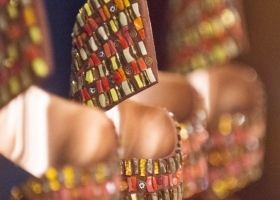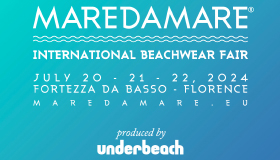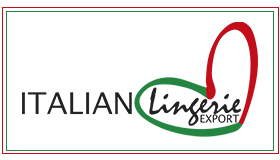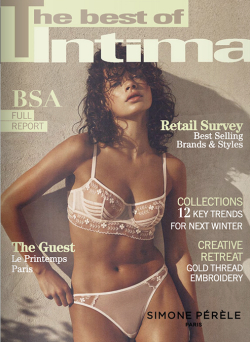
The Best ofIntima & Swim Edit
SHAPES AND COLORS
26 June 2017
From the 11th of November 2016 to the 1st of October 2017, The Museum of Printed Colors located in the French town of Mulhouse (“Le Musée de l’impression sur Etoffes de Mulhouse) is hosting a fabulous retrospective
The double exhibition unfolds with one dedicated to the progression of printed fabrics from the 18th century until now and the other honoring 20th century fashion designer’s most beautiful creations. What do they have in common? Color! On the one hand, “Shapes and Colors” invites the visitor to dive into a fascinating universe which is at once graphic, colorful, and spontaneous and abstract where the great masters of the 20th century are put in dialogue with the creations of brilliant textile draftsmen. With its inevitably colorful and superbly organized staging, the exhibition puts the creative process of successive generations of draftsmen on display. While on the other, “Constellation” focuses on the haute couture in color: from Loris Azzaro to Jean-Charles de Castelbajc, Pierre Balmain and Frank Sorbier, this part of the exhibition is a dazzling collection of colors, that come together to form an enchanting yet daring constellation.

SHAPES AND COLORS
“All of the action of the paint lives in the relationships between colors between shapes and between the colors and shapes.” While Auguste Herbin was referring to painting, the same can be said for patterns that decorate printed fabrics. Geometric shapes and colors are used to create a universal vocabulary- understood by all and applicable to every context. Shapes and colors offer almost endless combinations and possibilities but this simplicity is also a limitation. As a language it seems accessible to everyone, but just like with written words, sometimes it is more successful than others. Textile designers’ creative processes played a pioneering role in the use of shape and color.

The Development of the Indiennes
Since the second half of the 17th century the success of the first Indienne fabrics that arrived in the West was largely due to their rich colors. They illuminated interiors and European clothing alike. These fabrics quickly inspired western manufacturers and they formed the basis for the first decorative textile vocabulary. The natural colors, mainly indigo and madder, limited the creative pallet but the designers’ imaginations on the other hand had no limits when it came to creating new designs, which of course were necessary for commercial success. The fabrics needed to be attractive to entice customers and designs required constant reinvention. As a result, designers needed to completely master the use of form and color.
The harmony of colors is a recurring topic in the world of textiles. During antiquity the problem of color coordination and luminosity’s effect on weaving was already an issue. Originally, the colorist had only a few hues available. Up until the invention of the first synthetic colors in the 1850s, only natural colors, such as purple, madder, pastel, indigo, kermes, cochineal, saffron and sorrel, could be used for fabric dying and printing. In Alsace, Jean-Michel Haussmann (1742-1829), a manufacturer of Logelbach, became a pioneer as he improved the process of applying mordents to cotton and linen based fabrics. In the 1790s, some mineral dyes appeared such as iron oxide, antimony, Prussian blue and the bister obtained by manganese.
In the 18th century, the invention of the microscope provided inspiration for textile designers. They began to create abstract pieces resembling the human cell!
By the 19th century, chemistry was at its beginning and with it came an improved engraving technique and the use of wool. For commercial purposes, manufactures, inspired by the artistic movement at the time, used abstract or geometric shapes. They also became interested in contrasts and color blends using the third dimension to create kinetic fabrics.

Always More Color
During the 19th century, research carried out by Claude Louis Berthollet (1748-1822), Etienne Chevreul (1786-1889), Willhelm von Hofmann (1818 -1892) and William Henry Perkins (1838-1907) formed the scientific base for the composition of colors and lead to the creation of synthetic dyes. The enlargement of the chromatic scale, studies on the contrast and harmony of colors injected the textile universe with a renewed creativity, influencing the traditional decorative vocabulary and the work of both colorists and dyers. The works of Michel Eugène Chevreul (1786-1889) had a decisive influence on the decorative arts and, by extension, textile design. In 1864, he published a text on colors and their application in industrial arts. It offered chromatic circles to guide readers how to use colors harmoniously, which was actually more use to painters than textile designers.

Art and Textile
During the 20th century, modern painters such as Delaunay, Mondrian, Albers and Vasarely, joined in with the ideological discourse of the time. In the 1930s, the Art Deco style gave birth to geometrical patterns which matched the era’s trend for furniture and decoration. During the 1950s-60s, paintings inspired fashion and the world of textiles through movements such as geometric and lyric abstraction. In the 1970s, a kinetic geometry covered fabrics. Artistic movements influenced textiles. Sometimes, the designers were the trailblazers and they produced avant-garde patterns, sometimes, the contents were so inspiring that they were copied. In 1965, Yves Saint Laurent created his legendary Mondrain dress for his FW collection. The dress was inspired by famous painter Piet Mondrian, one of the creators of abstraction, and would be copied numerous times.
CONSTELLATION
The most emblematic creations of the 20th century’s greatest designers were brought together to form an unprecedented exhibition. If Azzaro is set apart by his evocative colors and daring cuts, then Jean-Charles de Castelbajac is distinguished by his use of primary colors and Kenzo brings a polychromatic exoticism to life. The haute couture creations of art master Franck Sorbier transport us to a world of color, opening the door to wild imagery. Jeanne Lanvin appreciated color enormously; some would go as far to say that she fetishized it. The colors of her fashion house, Lanvin blue, Polignac pink, in homage to her daughter, and Vélasquez green, were produced exclusively in her own dye workshop, founded in Nanterre in 1923.

Plunging us into a starry night, the silhouettes in this exhibition form
a rainbow of color…An invitation for the visitor to penetrate this
twilight universe and to be surprised by the multicolored and varied
creations. Doesn’t the very essence of a haute couture piece reside in
its shape, its material, its color?
The great designers of the
20th century are an inexhaustible inspiration on how to use shape and
color. A testimony for their time, to the evolution of tastes and
morals, they have played with the decorative vocabulary through their
creative processes. The shapes are cubist, deconstructed, geometric,
refined and in a reflection of primary colors themselves, luminous and
nuanced. Their work is not neutral but constitutes the very DNA of
creation and the sensibility of a creator.
Copyright 2024. All right reserved - Terms


















